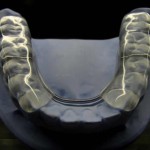
The aim of this trial was to compare the short- and long-term effectiveness of a prefabricated occlusal appliance with that of a stabilization appliance when treating headache in patients with myofascial pain.
A group of 66 patients attending two centres for Stomatognathic Physiology in Sweden and Finland 94% of whom suffered concomitantly from headache were randomly assigned to either a prefabricated (R) or a stabilization appliance (S) group. They were clinical evaluated and completed history questionnaires according to the Research Diagnostic Criteria for Temporomandibular Disorders at baseline and at 10-week and 6- and 12-month follow-ups.
They found
- There were significant decreases in the frequency and intensity of headache in both groups at all follow-ups, without statistically significant differences between groups.
- At baseline, 23 patients in both groups reported recurrent-continuous headache and, at 12 months, seven in the R group and four in the S group.
- The mean intensity (numeric rating scale) of headache prior to treatment decreased significantly at 12 months from 5.3 to 2.1 in the R group and from 6.1 to 2.9 in the S group.
- At the 12-month follow-up, 56% of patients in the R group reported a 30% reduction in intensity of headache and 50% a 50% reduction. In the S group, corresponding values were 39% and 36%, respectively.
- Non-specific physical symptoms were significantly associated with frequency of headache at baseline and at 6 months, and with depression at 6 and 12 months.
They concluded:-
The effectiveness of the prefabricated appliance seems to be similar to that of the stabilization appliance in the treatment of headache in patients with myofascial pain in both the short and long term.
Doepel M, Nilner M, Ekberg E, Vahlberg T, Bell Y. Headache: short- and long-term effectiveness of a prefabricated appliance compared to a stabilization appliance. Acta Odontol Scand. 2011 May;69(3):129-36. Epub 2010 Dec 9. PubMedPMID: 21142584.

There is some commonality between the ‘prefabricated appliance’ used in this study and the NTI-tss. I felt it disingenuous of the authors to question the use of the NTI-tss because of the ‘risk of undesired effects’.
John
There was an earlier systematic review that looked at the NTI-tss device :-
Stapelmann H, Türp JC. The NTI-tss device for the therapy of bruxism, temporomandibular disorders, and headache – where do we stand? A qualitative systematic review of the literature. BMC Oral Health. 2008 ( Pub Med Abstract) Which was commented on in Evidence-based Dentistry.